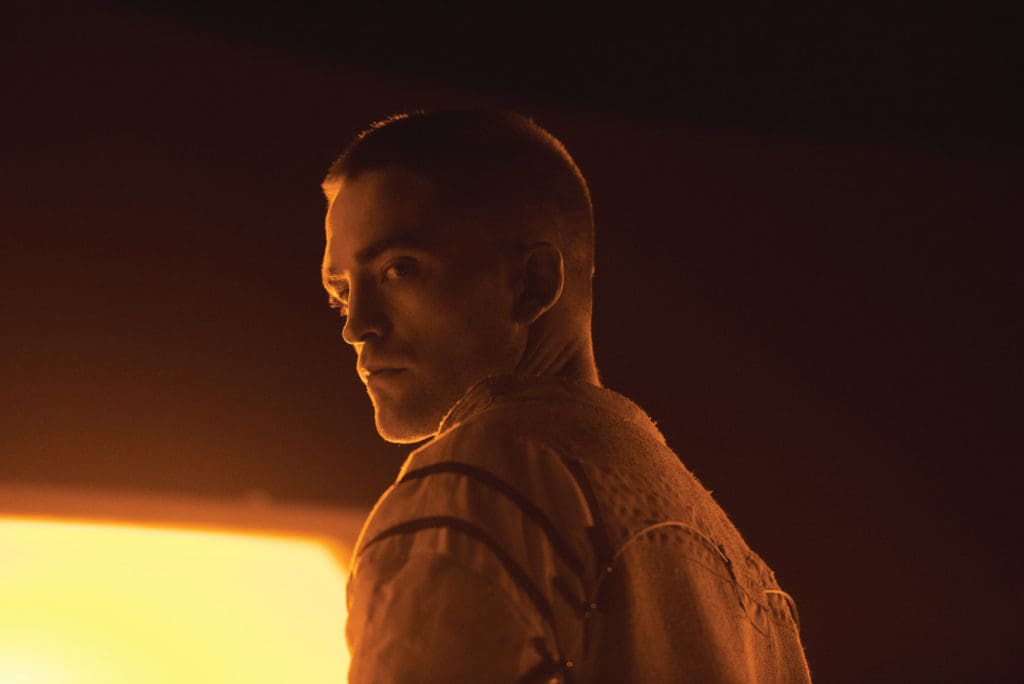
Written by Tom Moore
Boasting some darkly bone-chilling moments and some strong performances, writer/director Claire Denis’s High Life rises to the occasion as a solid exploration into isolation and loneliness, but crashes with its suspense and mystery elements.
The film follows a group of criminals sent into space in order to find alternative energy by extracting it from a black hole. However, plans change a bit when Dr. Dibs (Juliette Binoche) begins to use the prisoners as guinea pigs to create a child in space through artificial insemination. However, she can’t seem to get Monte (Robert Pattinson) to participate and his celibacy upsets her. With everyone else forced to participate in Dibs’s experiments and not allowed to have any sexual activity, tensions grow high and lead to some truly cruel acts that leave lasting impacts.
Space is often shown to be beautiful and characters are usually shown to have a sense of wonder towards it, but that’s not the case here. Every time we are shown the outside of the ship, space is shown as dark, silent, and daunting and it accurately reflects Denis’s desires to create a film about isolation. Even inside the ship, the darkened color palette and some great shots of the interior really create this sense of loneliness throughout—even when there are a good amount of people.
This idea of loneliness is also represented well with Pattinson’s strong performance. Obviously, being the only celibate crew member on the ship makes him kind of alone already, but Pattinson’s performance heightens this as Monte’s slow-building frustrations and sense of worry that things won’t turn out OK are felt throughout the film. Pattinson also displays some of Monte’s more caring and fatherly aspects with some interesting scenes early on with his daughter.
Binoche also puts in a haunting performance that shows the lengths that Dibs will go to have success with her experiment. Her performance is stellar and she helps create some of the most bone-chilling moments of the film. The rest of the cast is solid–even if we don’t get to know them that much–and there’s even an excellent baby performance from Scarlet Lindsey with, surely, some great direction from Denis that makes a solid impact in the film’s opening.
Outside of High Life’s clear themes of loneliness, there are also some discussions and ideas thrown around about human sexual desire that are interesting. There’s sort of this underlying conflict between the crew and Dibs about the importance of sex and the lengths people will go for sexual pleasure. This is why those tease Monte for not wanting to sexually participate at all and why they even question him for not using a special box that lets them masturbate. It’s an interesting conflict that’s felt throughout the film and leads to some actions that are down-right tough to watch.
Where High Life, unfortunately, starts to falter is in its storytelling, as it reveals the fates of many of the characters in its opening and strips away a lot of the film’s suspense and mystery. While the “how” isn’t fully revealed in the film’s opening, the “who” is and just by seeing that, you get a sense of who bites the dust and who doesn’t. This isn’t to say that other films, like Pulp Fiction and Slumdog Millionaire, haven’t done this and that telling a story out of sequence can’t work, but the payoff in learning how everything unfolded must be big enough to be satisfying and I can’t say that that happens in High Life. There are definitely some shocking and disturbing moments and interesting hints that explain how Monte is forced to do the things he has to do in the opening, but there’s nothing too shocking that makes the lack of suspense worth it.
Frankly, telling the story in a more linear fashion would’ve added more impactful layers to Monte’s isolation. Not only would it give viewers a solid understanding of what’s happening from start to finish, but they would feel like something is building throughout the film rather than just in isolated moments. In some ways, viewers are taken out of the experience entirely because of it and constant cuts and thoughts that Monte has feel random rather than impactful.
There’re some moments where viewers are initially meant to think that Monte is seeing crew members that are already gone because of how the film is cut, but that’s not the case and it leads to moments that had me saying a disappointing “oh” rather than a surprising “whoa.” If the story were told in a more linear fashion, these shots and cuts could’ve actually been used to show Monte’s slowly deteriorating mind because of his loneliness and capture the film’s isolated tones much better. This lets viewers be a part of Monte’s experience and connect to it as well as build suspense and tension much better by keeping viewers in the dark rather than giving them an early glimpse behind the curtain.
Still, even with these story issues, there’s something about High Life that’s intriguing. A lot of the credit for the film’s highest achievements has to go to Denis as her writing and direction create some unique moments. She clearly has a unique vision and, with some fine-tuning to her storytelling, High Life could have been great.

